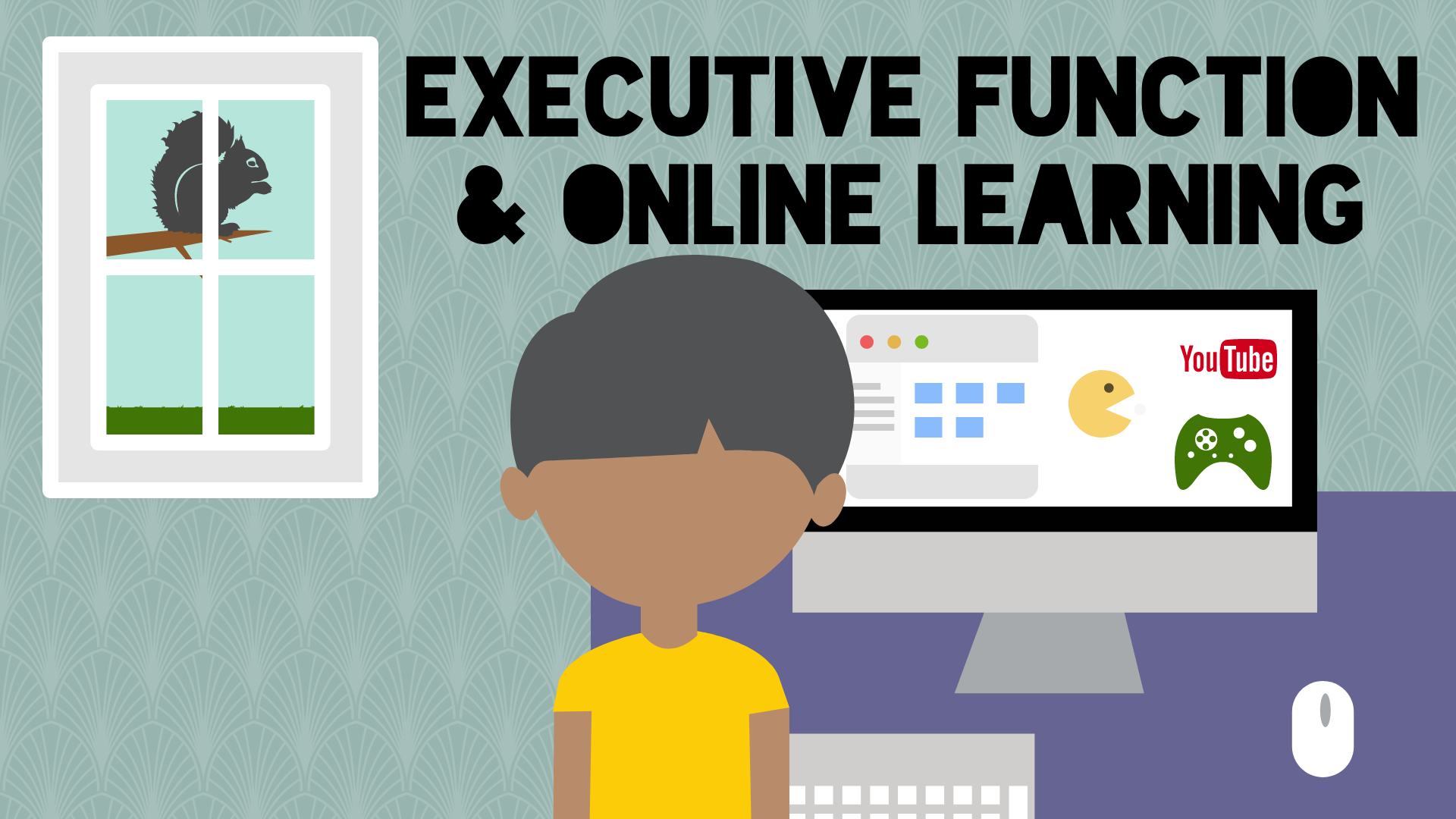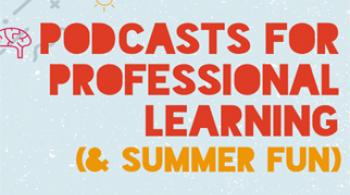
By Lisa Beth Carey, EdD
Graphic Created By Erin F. Jones

Imagine: It’s early in the morning. You go to your kitchen and go through all of the motions of brewing yourself a cup of coffee. You can do this half-asleep because you’ve done it so many times before.
Now imagine: You wake up and realize the power went out overnight. You’re running late, the coffee maker’s not turning on, and you realize that you need to go find the circuit breaker to restore power to the outlet. This new set of circumstances is out of the ordinary. Nothing about the power being out is rehearsed. This morning, you cannot brew your cup of coffee while half-asleep. In order to complete the task of making your morning coffee, you will need to use a set of cognitive skills called executive function.
Executive function is an umbrella term for the cognitive skills that work together to help us complete a task or goal (Diamond, 2013). The core executive function skills are inhibitory control, working memory and flexible thinking (Baggata & Alexander, 2016; Nigg, 2016).
- Inhibitory control: Purposefully stopping/pausing when your immediate reaction will not help you accomplish your task.
- Working memory: Holding information in mind temporarily in order to manipulate it.
- Flexible thinking: Switching between different concepts and considering multiple perspectives and scenarios.
Executive function skills work interactively to support our ability to perform tasks that are novel or under-practiced. This important set of skills develops from birth through young adulthood, providing ample time to be shaped by the environment (Diamond, 2013). How we design our learning environments to support the development and use of executive function, or over-burden these still-developing skills, has a major impact on student academic achievement.
How Does Student Executive Function Interact With the Learning Environment?
How well we perform any skill is based on how well-matched our skill is to the demands of the context. For example, I’m a very strong swimmer, but put me in a riptide after a long day of swimming, and I’ll struggle, possibly even drown. Executive function is similar to swimming in various conditions. A calm, shallow pool is very different from rough, deep open water.
Likewise, students will do much better in a well-supported learning environment that matches their executive function skill levels, as opposed to in an unsupported learning environment with multiple executive function demands that are mismatched to their skill development. When there is a mismatch between the executive function demands and the skills of the individual, the result is an expression of executive dysfunction (Jacobson & Mahone, 2012).
Behavioral indicators of executive dysfunction (Gioia, Isquith, Guy, & Kenworthy, 2015) include:
- Impulsivity
- Distractibility
- Difficulty with complex task completion
- Difficulty with transitioning between activities
- Difficulty shifting patterns of thought
How Does Online Learning Impact Student Executive Function?
An online learning environment is often highly demanding of student executive functions. This is even more true if the device, software, application or website being used is new, or if the student has limited experience using it for learning activities. Many times, we ask students to use an unfamiliar device, software, application or website on top of learning new academic content or skills. This causes many students to struggle to use their executive function skills to engage in tasks meaningfully. They start to exhibit the behavioral indicators of executive dysfunction listed above.
For example, students who are asked to use new software to record a response to a reading comprehension prompt will need to use their executive function skills to navigate the software, while also engaging their executive functions to organize their thinking and respond to the prompt. This combination of executive function demands is very likely to overwhelm a student and lead to difficulty completing the task.
In studies of students using personal devices (tablets, laptops, phones, etc.) for learning activities, teachers and students reported increases in student behaviors that aligned with the behavioral indicators of executive dysfunction (Islam & Gronlund, 2016; Kay, Benzimra & Li, 2017; Lei & Zhao, 2008; Sarıtepeci & Durak, 2017; Tallvid, 2016; Tallvid et al., 2015). Students using personal digital devices were more likely to become easily distracted, had trouble initiating and completing tasks, were engaged with off-task media or were attempting (unsuccessfully) to multitask, and had difficulty problem-solving when technology didn’t work as expected.
If we consider the role environmental demands play in students’ ability to use their executive function skills during learning activities, it’s unsurprising that online learning environments would place greater demand on student executive function skills. There are more chances for distraction, and thus more need to inhibit responses to all types of exciting stimuli (e.g., a chat from a friend or a link to a YouTube video). There are increases in information, and thus a greater demand on working memory. There are more ways in which to navigate a digital device than a notebook, and thus a greater demand on flexible thinking.
This is not to say that we should ditch our tech! Technology offers greater amounts of accessibility, connectiveness and collaboration. And in the age of COVID-19, we really need technology to safely connect at a distance. We just need to make sure that we are mindful of creating online learning environments that are responsive to student neurodevelopment (meaning that we don’t overtax student executive function with too many novel tasks and digital tools) and that provide executive function support as needed.
Tips for Supporting Executive Function During Online Learning
In any learning environment, we should take a two-fold approach to avoiding contributing to student executive dysfunction. We should reduce executive function demands that are extraneous to the content being taught, and we should provide supports, as needed.
As you design your online learning environment, ask yourself the following questions:
- Is my instructional design/tool/learning management system (LMS) overly demanding on my students’ inhibitory control? (i.e., do they have to focus on stopping/pausing impulses to engage in the task?)
- What can I do to reduce the demand?
- What support options can I add?
- Is my instructional design/tool/LMS overly demanding on my students’ working memory? (i.e., do they have to keep multiple pieces of information in mind as they manipulate the information to complete the task?)
- What can I do to reduce the demand?
- What support options can I add?
- Is my instructional design/tool/LMS overly demanding on my students’ flexible thinking? (i.e., do they have to focus on coming up with multiple ways to approach a task or problem, and do they need to independently troubleshoot their technology?)
- What can I do to reduce the demand?
- What support options can I add?
Striking the balance between executive function demands and supports is critical for students to get the most out of their online learning experience. Keep in mind that students are highly variable, and that supports will need to be flexible to meet the needs of your various students. Stay tuned for future posts that include teacher experiences teaching online while considering student executive function!
References:
Baggetta, P., & Alexander, P.A. (2016). Conceptualization and operationalization of executive function. Mind, Brain, and Education, 10(1), 10–33.
Diamond, A. (2013). Executive functions. Annual Review of Psychology, 64, 135–168.
Gioia, G.A., Isquith, P.K., Guy, S.C., & Kenworthy, L. (2015). BRIEF2: Behavior Rating Inventory of Executive Function (2nd ed.). Lutz, FL: Psychological Assessment Resources, Inc.
Islam, M.S., & Gronlund, A. (2016). An international literature review of 1:1 computing in schools. Journal of Educational Change, 17, 191–222.
Jacobson, L.A., & Mahone, E.M. (2012). Educational implications of executive dysfunction. In S.J. Hunter & E P. Sparrow (Eds.). Executive Function and Dysfunction: Indentification, Assessment and Treatment (ed., pp. 231–246). Cambridge, MA: Cambridge University Press.
Kay, R., Benzimra, D., & Li, J. (2017). Exploring factors that influence technology-based distractions in bring your own device classrooms. Journal of Educational Computing Research, 55(7), 974–995.
Lei, J., & Zhao, Y. (2008). One-to-one computing: What does it bring to schools? Journal of Educational Computer Research, 39(2), 97–122.
Nigg, J.T. (2016). Annual Research Review: On the relations among self‐regulation, self‐control, executive functioning, effortful control, cognitive control, impulsivity, risk‐taking, and inhibition for developmental psychopathology. Journal of Child Psychology and Psychiatry, 58(4), 361–383.
Sarıtepeci, M., & Durak, H. (2016). Examining student perceptions regarding to usage purposes of tablet computers distributed under the scope of in FATIH project in the course processes and by students. Participatory Educational Research, IV, 171–181.
Tallvid, M., Lundin, J.L., Svensson, L., & Lindstrom, B. (2013). Relationship between sanctioned and unsanctioned laptop use in 1:1 classroom. Educational Technology & Society, 18(1), 237–249.
Tallvid, M. (2016). Understanding teachers’ reluctance to the pedagogical use of ICT in the 1:1 classroom. Education and Information Technologies, 21(3), 503–519.















